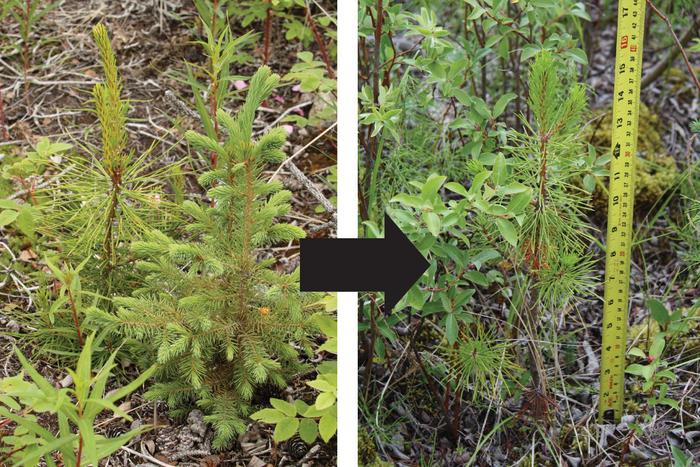The Ecological Society of America (ESA) presents a roundup of four research articles recently published across its six esteemed journals. Widely recognized for fostering innovation and advancing ecological knowledge, ESA’s journals consistently feature illuminating and impactful studies. This compilation of papers explores the potential for pines to establish in pine-free interior Alaska, internet sleuthing to assess birds’ extinction risk and more, showcasing the Society’s commitment to promoting cutting-edge research that furthers our understanding of the natural world.

Credit: Jill Johnstone
The Ecological Society of America (ESA) presents a roundup of four research articles recently published across its six esteemed journals. Widely recognized for fostering innovation and advancing ecological knowledge, ESA’s journals consistently feature illuminating and impactful studies. This compilation of papers explores the potential for pines to establish in pine-free interior Alaska, internet sleuthing to assess birds’ extinction risk and more, showcasing the Society’s commitment to promoting cutting-edge research that furthers our understanding of the natural world.
From Ecological Applications:
Lodgepole pine staking a claim to Alaska’s boreal region
Author contact: Xanthe J. Walker (xanthe.walker@nau.edu)
Shifts in species ranges driven by ongoing climate change are perhaps nowhere more evident than in the rapidly warming northern latitudes of the world. In this study, researchers used a combination of field experiments and model simulations to assess the susceptibility of Alaska’s boreal forests, where pine trees are currently absent, to colonization by lodgepole pine from forests in the neighboring Yukon Territory. They found that lodgepole could readily establish across their field sites as environmental conditions become increasingly suitable with little resistance from natural checks like browsing by moose and hare and competition from native trees. Based on their results, the authors warn that lodgepole pine could become widely distributed throughout the boreal regions of Alaska as natural constraints on their distribution wane under future climate conditions, resulting in a fundamental shift in ecosystem structure with considerable ecological, socioeconomic and cultural ramifications.
Read the article: Factors limiting the potential range expansion of lodgepole pine in Interior Alaska
A recipe for more deer in Washington state
Author contact: Taylor R. Ganz (taylorganz@gmail.com)
White-tailed deer in northeastern Washington State are vulnerable to apex predators and vehicle collisions on roads, but they also benefit from areas opened by timber extraction and agriculture according to the authors of this study. Analysis of radio-collar data from 280 deer revealed that predators—particularly cougars—had a marked effect on deer numbers. However, substantial increases in edible vegetation in recently logged areas, farmland and ranches boosted deer abundance and played an even larger role in driving deer population growth when compared to predation. Consequently, the authors propose that strategies promoting greater availability of forage would be the most effective approach for increasing white-tailed deer in the state. Moreover, a substantial portion of the tracked deer were killed by cars and trucks on the region’s roads, leading the authors to recommend actions to reduce deer-vehicle collisions—for both humans’ and deer’s sakes.
Read the article: White-tailed deer population dynamics in a multipredator landscape shaped by humans
From Ecosphere:
Honey bee pathogens are a bumble bee buzzkill
Author contact: Heather M. Hines (hmh19@psu.edu)
A new study suggests that honey bees may be serving as a winter reservoir of viral pathogens that go on to infect common eastern bumble bees in spring. Although parasite prevalence is relatively high in both bees in summer, loads decline to negligible levels in overwintering bumble bees. In contrast, honey bees appear to be less adept at ridding themselves of these nuisances and they maintain higher viral loads during the wintertime. Come spring, the larger parasite load carried by honey bees through the winter can then be passed to bumble bees. The findings have important ecological implications but may also aid in the development of more effective management strategies aimed at improving the survival of these indispensable pollinators.
Read the article: Comparison of seasonal viral prevalence supports honey bees as potential spring pathogen reservoirs for bumble bees
From Frontiers in Ecology and the Environment:
Looking online for long-lost birds
Author contact: Cameron L. Rutt (cameronrutt@gmail.com)
Catalogs of data collected by hobbyists and amateur scientists (both skilled and novice) on the world’s birds are now so extensive that they can serve as a reliable index of extinction risk, propose the authors of this new study. Analysis of 42 million photographic, audio and video records uploaded to popular online platforms like eBird and iNaturalist revealed that 144 (1.2%) of the nearly 12,000 known avian species across the globe meet the criteria of “lost,” which the authors define as the absence of solid documentation for more than a decade. Moreover, they suggest that the length of time since the last record of a species, combined with the collective effort spent searching for it, reflect a bird’s odds of being imperiled. Based on this measure, the researchers estimated that nearly 62% of the “lost” species are likely gone for good. The study highlights the value of these so-called citizen science or community science platforms, for biodiversity writ large.
Read the article: Global gaps in citizen-science data reveal the world’s “lost” birds
###
The Ecological Society of America, founded in 1915, is the world’s largest community of professional ecologists and a trusted source of ecological knowledge, committed to advancing the understanding of life on Earth. The 8,000 member Society publishes six journals and a membership bulletin and broadly shares ecological information through policy, media outreach and education initiatives. The Society’s Annual Meeting attracts 4,000 attendees and features the most recent advances in ecological science. Visit the ESA website at
Follow ESA on social media:
Twitter/X – @esa_org
Instagram – @ecologicalsociety
Facebook – @esa.org



